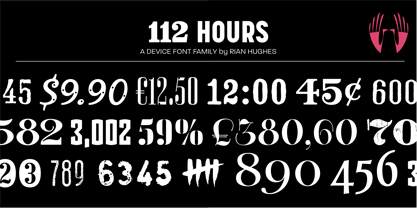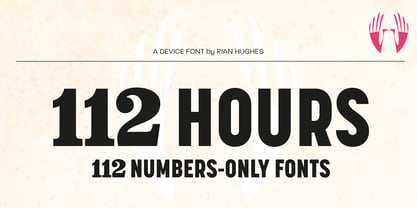Über die Schriftfamilie 112 Hours
Rian Hughes’ 15th collection of fonts, “112 Hours”, is entirely dedicated to numbers.
Culled from a myriad of sources – clock faces, tickets, watches house numbers – it is an eclectic and wide-ranging set.
Each font contains only numerals and related punctuation – no letters.
A new book has been designed by Hughes to show the collection, and includes sample settings, complete character sets, source material and an introduction. This is available print-to-order on Blurb in paperback and hardback:
http://www.blurb.com/b/5539073-112-hours-hardback
http://www.blurb.com/b/5539045-112-hours-paperback
From the introduction:
The idea for this, the fifteenth Device Fonts collection, began when I came across an online auction site dedicated to antique clocks. I was mesmerized by the inventive and bizarre numerals on their faces. Shorn of the need to extend the internal logic of a typeface through the entire alphabet, the designers of these treasures were free to explore interesting forms and shapes that would otherwise be denied them.
Given this horological starting point, I decided to produce 12 fonts, each featuring just the numbers from 1 to 12 and, where appropriate, a small set of supporting characters — in most cases, the international currency symbols, a colon, full stop, hyphen, slash and the number sign. 10, 11 and 12 I opted to place in the capital A, B and C slots. Each font is shown in its entirety here.
I soon passed 12, so the next logical finish line was 24. Like a typographic Jack Bauer, I soon passed that too -— the more I researched, the more I came across interesting and unique examples that insisted on digitization, or that inspired me to explore some new design direction.
The sources broadened to include tickets, numbering machines, ecclesiastical brass plates and more. Though not derived from clock faces, I opted to keep the 1-12 conceit for consistency, which allowed me to design what are effectively numerical ligatures.
I finally concluded one hundred fonts over my original estimate at 112. Even though it’s not strictly divisible by 12, the number has a certain symmetry, I reasoned, and was as good a place as any to round off the project.
An overview reveals a broad range that nonetheless fall into several loose categories. There are fairly faithful revivals, only diverging from their source material to even out inconsistencies and regularize weighting or shape to make them more functional in a modern context; designs taken directly from the source material, preserving all the inky grit and character of the original; designs that are loosely based on a couple of numbers from the source material but diverge dramatically for reasons of improved aesthetics or mere whim; and entirely new designs with no historical precedent.
As projects like this evolve (and, to be frank, get out of hand), they can take you in directions and to places you didn’t envisage when you first set out. Along the way, I corresponded with experts in railway livery, and now know about the history of cab side and smokebox plates; I travelled to the Musée de l’imprimerie in Nantes, France, to examine their numbering machines; I photographed house numbers in Paris, Florence, Venice, Amsterdam and here in the UK; I delved into my collection of tickets, passes and printed ephemera; I visited the Science Museum in London, the Royal Signals Museum in Dorset, and the Museum of London to source early adding machines, war-time telegraphs and post-war ration books.
I photographed watches at Worthing Museum, weighing scales large enough to stand on in a Brick Lane pub, and digital station clocks at Baker Street tube station.
I went to the London Under-ground archive at Acton Depot, where you can see all manner of vintage enamel signs and woodblock type; I photographed grocer’s stalls in East End street markets; I dug out old clocks I recalled from childhood at my parents’ place, examined old manual typewriters and cash tills, and crouched down with a torch to look at my electricity meter.
I found out that Jane Fonda kicked a policeman, and unusually for someone with a lifelong aversion to sport, picked up some horse-racing jargon.
I share some of that research here. In many cases I have not been slavish about staying close to the source material if I didn’t think it warranted it, so a close comparison will reveal differences. These changes could be made for aesthetic reasons, functional reasons (the originals didn’t need to be set in any combination, for example), or just reasons of personal taste. Where reference for the additional characters were not available — which was always the case with fonts derived from clock faces — I have endeavored to design them in a sympathetic style.
I may even extend some of these to the full alphabet in the future. If I do, these number-only fonts could be considered as experimental design exercises: forays into form to probe interesting new graphic possibilities.
112 Stunden
Über Gerät
Device Fonts ist der Font Zweig des Device-Studios von Rian Hughes, das in Kew Gardens, London, ansässig ist. Device Fonts wurde 1997 gegründet, um die wachsende Schriftbibliothek von Hughes zu verwalten und trug schon früh zur FontFont-Reihe von FontShop bei. Es hat über 200 Originalschriften Schriften mit mehr als 1000 individuellen Schriftschnitten veröffentlicht, darunter auch Sonderentwürfe für so unterschiedliche Kunden wie Mac Nutzer, 2000AD und die Teenage Mutant Ninja Turtles. Rian hat am London College of Communication in London studiert, bevor er für eine Werbeagentur, Smash Hits, die Zeitschrift i-D und eine Reihe von Unternehmen für die Gestaltung von Plattenhüllen arbeitete. Unter dem Studiobanner Device bietet er Design, individuelle Schriften und Illustrationen für Werbekampagnen, Plattenhüllen, Buchumschläge, Graphic Novels und das Fernsehen an. Er entwarf Plakate für die Yellow Boots-Kette des Tokioter Modeunternehmens Juni Co., den animierten On-Board-Sicherheitsfilm für Virgin Airlines, die Eurostar-Plakatkampagne, eine Kollektion hawaiianischer Hemden, eine Reihe von Uhren für Swatch, die Broschüre für die MTV Europe's Music Awards sowie zahlreiche Illustrationen für Buchumschläge und CD-Cover. Er hat viele Logos für DC, Marvel, Valiant, Image und andere Comicfirmen für Titel wie Batman, die X-Men, James Bond, The Avengers und Spider-Man entworfen. Seit langem mit der Welt der Comics verbunden, war Rian Hughes' erste Graphic Novel "The Science Service" für den belgischen Verlag Magic Strip. Es folgte "Dare" für das kurzlebige IPC-Magazin "Revolver", eine "ikonoklastische Neuauflage des Comic-Helden Dan Dare aus den 50er Jahren", geschrieben von Grant Morrison. Seine Strips aus der Galaxy's Greatest wurden in 'Yesterday's Tomorrows' ('Dare', 'Really and Truly' und andere) und 'Tales from Beyond Science' (geschrieben von Mark Millar, John Smith und Alan McKenzie) gesammelt. In jüngster Zeit schrieb und zeichnete er eine "Batman: Black and White"-Geschichte, trug zu "Vertigo: Magenta" bei, gestaltete die Karte des DC-Multiversums und war mit Morrison für zwei Geschichten für das Magazin "Heavy Metal" wiedervereint. Er hat an zahlreichen internationalen Ausstellungen teilgenommen und sowohl im Vereinigten Königreich als auch international zahlreiche Vorträge gehalten. 2003 fand in der Conningsby Gallery in London eine Einzelausstellung seiner Werke statt. Eine retrospektive Monografie, "Art, Commercial", wurde 2002 veröffentlicht, und "Ten Year Itch", eine Feier der ersten zehn Jahre von Device Fonts, wurde 2005 veröffentlicht. Zu den jüngsten Büchern gehören "Custom Lettering of the 20s and 30s" und die altersunabhängige, wortlose Graphic Novel "I Am A Number", "Soho Dives, Soho Divas" sammelt seine burlesken Zeichnungen, und in " Cult-Ure" legt er sein Memetik-Manifest dar : Ideas Can Be Dangerous. Eine Sammlung seiner Logodesigns, "Logo a Gogo", wurde 2018 von Korero Press veröffentlicht. Er hat eine Sammlung von Thunderbirds-Erinnerungsstücken, einen Kühlschrank voller Wodka und einen Stapel von Easy-Listening-CDs Alben , die er sehr leise spielt. www.rianhughes.com www.devicefonts.co.ukThePremium Foundry Seite kann hier eingesehen werden .
Mehr lesen
Weniger lesen


